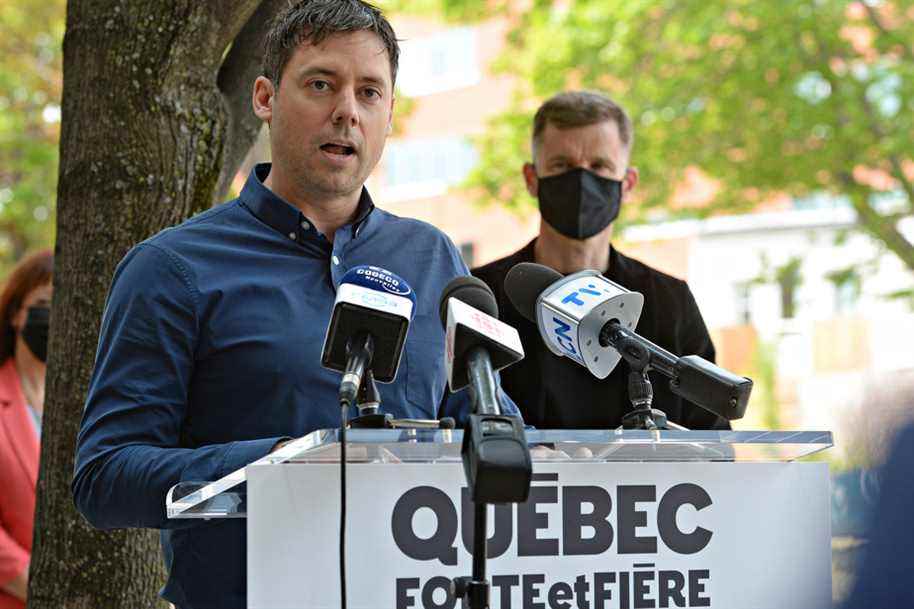(Quebec) The capital has the reputation of being only a “city of tanks”, a label which annoys the new person in charge of the transport file at the city hall of Quebec, himself a cyclist who does not have car.
“It should no longer be a place just for the car”, launches Pierre-Luc Lachance, recently appointed vice-president of the executive committee, during a meeting with Press.
“We have to think of the streets in terms of active travel, because that’s what we want to focus on. ”
The 40-year-old is an avid cyclist. But the morning of our interview, he had gone to City Hall by bus. He is also a member of Communauto and occasionally borrows his girlfriend’s car.
He manages his trips according to what experts call the “transport cocktail”. And he is not the only one: according to his calculations, three other members of the new executive committee do not own a car.
This reality may seem surprising in Quebec. But Mr. Lachance specifies that it fits well with the promises of strong and proud Quebec (QFF) in terms of mobility.

PHOTO YAN DOUBLET, ARCHIVES THE SUN
Bruno Marchand, new mayor of Quebec
Bruno Marchand repeated during the campaign not to want to make motorists feel guilty, but rather to offer them alternatives to the car.
The new mayor, for example, wants to set up a sort of mobility platform, with all the options at your fingertips, from the bus to bike-sharing, including the future tramway and car-sharing.
“Transport is not just a mode, it is the interconnection of a set of modes,” says Mr. Lachance, who has just been appointed responsible for transport, mobility and transport issues. the circulation.
A former Team Labeaume
Pierre-Luc Lachance surprised many observers by announcing last April that he was leaving Team Labeaume. A month later, the Saint-Roch – Saint-Sauveur district councilor joined Bruno Marchand.
This “assumed geek”, who was director general of Québec Numérique before his leap into politics, was elected for the first time in the 2017 elections. But he explains that he was disappointed with the Labeaume administration.
My three fundamental values are authenticity, collaboration, creativity. […] Mr. Labeaume, I joined him because he is a visionary, a project guy. But these values were not met. It was there that I decided to become independent.
Pierre-Luc Lachance, Vice-President of the Executive Committee of the City of Quebec
By making the jump to QFF, Pierre-Luc Lachance became his first and only advisor last spring. Then, in the November 7 elections, he was re-elected in Saint-Roch by defeating Team candidate Marie-Josée Savard, who was none other than Régis Labeaume’s former press secretary, Paul-Christian Nolin.
This bet was well rewarded after the elections. Bruno Marchand made Pierre-Luc Lachance an important elected member of his administration by appointing him vice-president of the executive committee.
Promises in spades
Expectations are high among pedestrians and cyclists in Quebec. They have been deploring for years, following public consultations, the poor development of the City which has stagnated active transport.
The new administration has vowed to address these shortcomings. Mr. Marchand was committed to more than doubling the snow-plowed bike paths in winter, to increasing safety near schools, to reducing speed in many streets, to removing the posts from the sidewalks in the city center, to increasing the protrusions. , to extend the time it takes for pedestrians to cross …
The Marchand administration also intends to create a network of shared streets. These streets, which already exist in small numbers in Quebec, are inspired by the Dutch “woonerfs”: pedestrians and cyclists have priority and cars cannot exceed 20 km / h.
“When we are going to repair streets, we will think about creating a network that will prioritize pedestrians and cyclists,” says Mr. Lachance, who also wants them to be cleared as a priority in winter.
The purpose of all these measures, he explains, is to allow families to do without one of their two cars, or simply do without a car.
Quebec has 1.31 vehicles per household. This is much less than the 1.65 vehicles per household in Lévis, but still more than on the Island of Montreal (1.01 vehicles per household).
“If we manage to lower that figure because we have a better public transport offer, that people are comfortable using the bike because the facilities are intelligently designed… So there we have just decided putting money in the pockets of citizens, says Pierre-Luc Lachance. We have just reduced our carbon footprint. It’s a win-win situation. ”

